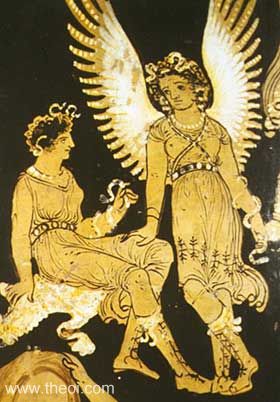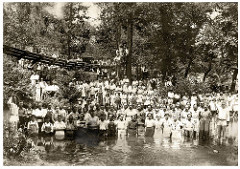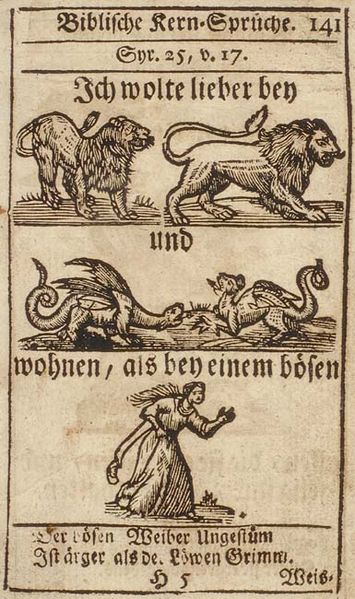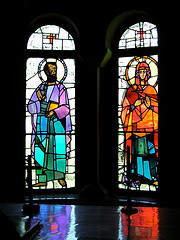Continuing notes from reading of Tyson’s Marcion and Luke-Acts. . . .
After discussing the shifting directions of the scholarly debates over Paul’s characterization in Acts vis a vis the Paul we find in the epistles, Tyson asks if a more definitive answer is to be found to the question of whether the Paul of Acts is a most appropriate response to the Paul of the Marcionites.
Parallell Lives
Tyson first addresses the contribution of Clark’s Parallel Lives to understanding the author of Act’s intention to portray Paul in both continuity and unity with Peter and the Twelve. He adds to Clark’s work the observation that the influence of Plutarch’s influence on the author of Acts “is more credible if we date Acts after ca. 115 c.e., since it is probable that the Parallel Lives [by Plutarch] was not published before that date.” (p.63)
Objective reference
But more significantly, Tyson notes that Clark’s work on the reasons for the author’s creation of parallels between the lives of Paul and Peter is based on internal criteria alone and lacks an objective external reference. Clark’s argument for certain themes and reasons for his parallels would be more credible if one could show how they were a fitting response to a known historical challenge. Tyson is, of course, arguing that the Marcionite challenge was the appropriate historical situation which would best explain Clark’s understanding of Luke’s characterization of Paul (through parallels with Peter et al).
Tyson looks at the history of attempts to reconcile the Paul of Acts and the Paul of the letters.
F. C. Baur
Author of Acts rewrote the characters of Paul and Peter to show them united theologically — in support of the Law. Contrast “the real Paul” who was anti-Torah.
Adolf von Harnack
Paul’s attitude to the Torah was complex and not a blanket opposition to it. Luke had not found the Torah the same theological challenge that Paul had, and in his portrayal of Paul he brings out the more Jewish side of Paul as he (Luke) knew him.
Philip Vielhauer
In natural theology, Luke portrayed Paul as a Stoic philosopher for whom knowledge of God could be acquired naturally and positively, apart from revelation — which was the view of the Paul of the letters.
In Christology, Acts is adoptionist, and the cross of Christ was a wrongful murder of an innocent man for which the Jews were culpable — unlike Paul of the letters for whom the cross was a saving event, a means of judgment and reconciliation.
In eschatology, Paul relegates the coming judgment and resurrection to a tail end position in his message — unlike the Paul of the letters who whom it was central and imminent.
In the law, Acts avoids the real complexities of Paul’s attitude toward the Torah, and presents him as a faithful Pharisee in practice, as demonstrated by:
- his missionary practice of going to the synagogue Jews first and only turning to gentiles after a formal rejection there
- his submission to Jerusalem authorities
- his circumcision of Timothy
- his spreading the apostolic decrees
- his vow
- his trips to Jerusalem to observe religious festivals
- his concurring with James in participating in a Nazirite vow
- his emphasizing his Pharisee status when on trial
Ernst Haenchen
The author of Acts justified the gentile mission as simply being God’s will, unaware of Paul’s more complex justification from his arguments about the Law. Author of Acts also missed the real contention at the heart of Paul’s theology. To Luke, this was the resurrection. The real issue, the Torah, was only alluded to in Acts as a false accusation against Paul. Also, to Haenchen, Acts differed from the letters by presenting Paul as a miracle worker and great orator, but not as an apostle.
Jacob Jervell
The letters of Paul addressed specific issues and do not present a full biography. Acts and the letters are needed for a complete picture. Except for Romans 9-11, the points of theological contact are between the Paul in Acts and the marginal notes in the letters.
Stanley E. Porter
Disputes Haenchen’s and Vielhauer’s interpretations of the wide gulf between the Paul of the letters and of Acts. The Paul of the letters can also be seen as a miracle worker and orator. Porter also argues more weight should be given to the two times in Acts when Paul is called an apostle. And the accusations in Acts that Paul taught against Torah argue for the author’s knowing of the importance of the Torah in Paul’s message, and that the different emphases between Acts and the epistles are the result of different genres.
Mark D. Nanos
The letter to Galatians is an “ironic rebuke” of the converts. “Judaizers” are not opposed to belief in Christ but only to the idea that circumcision (becoming a full proselyte) is not also necessary to be part of Israel. Paul had taught them that belief in Christ was all that was necessary. He does not attack Torah observance or question its appropriateness for non-Christian Jews. The issue is not faith in Christ versus Torah observance. Nanos’s understanding of Galatians is that of a Paul close to the one in Acts.
Joseph B. Tyson
Despite interpretations that appear to lessen the divide between the Paul of the letters and Acts, it is difficult to reconcile:
- Paul’s views in Galatians with the Paul in Acts 16 who would circumcise Timothy
- Paul’s rejection of his past in Phil 3:1-11 with his maintenance of it in Acts 23:6
- Paul’s vehement defining of himself as an apostle in Gal 1:1, Rom 1:1; 1:13; 1 Cor 1:1; 9:1, 2; 15:9; 2 Cor 1:1; 12:12 with the almost total denial of the title to him in Acts
A final settlement of the apparent conflicts between the Paul of the epistles and the Paul of Acts still escapes us.
But if “Acts was written in the first half of the second century, . . . its characterization of Paul and Pauline theology may be understood as an extraordinarily appropriate attempt to correct the teachings of Marcionite Christianity.” (p.68 )
Whatever role Paul played during his own lifetime, there appears to be a struggle for his legacy in the second century. (Compare post comparing Pastorals with Acts of Paul and Thecla.) Marcionites used Paul as their authority for rejecting the Torah, Hebrew Scriptures and Jewish customs. Acts responds(?) by representing him as a faithful Jew and Pharisee.
Tyson then singles out three major features of Paul’s characterization in Acts, drawing on features Vielhauser believed were divergences from the epistles, and including observations of their themes and literary patterns, to show how they qualify as responses to Marcionism.
1. Paul’s Missionary Method
Tyson has earlier covered the literary pattern used for the missionary narratives and the themes they support. See Marcionite Context 1 for an elaboration of this and what follows.
The narratives of Paul’s mission work regularly consists of the same fourfold patterning of the following four themes:
- fidelity of the believing community to the Jewish traditions and practices — Paul always begins with the synagogue
- the community’s inclusion of Gentiles
- Jewish rejection of the Christian message
- Jewish opposition to the community
Further, “the heart of Paul’s message in the synagogues is that Jesus is the fulfillment of Jewish expectation and prophetic promises.” (p.69)
Note how these themes fit hand in glove with the Marcionite challenge:
Marcion insisted that the Christian message consisted of a rejection of the Jewish Torah and Scriptures. Yet in Acts Paul is found returning again and again to the synagogue. There is a rift between Jew and Christian, yes, but the reason for this is clearly the fact that the Jews themselves are rejecting the message. And they are doing so not because the message is anti-Jewish, or anti-Torah or anti-Hebrew-Scriptures, but because of their hard stubborn hearts. The Christian message is that Jesus is the fulfillment of their Scriptures and Messianic hopes, and this is what angers them.
Paul’s repeated attempts to convert the Jews by showing them he was sympathetic and obedient to their customs and by preaching that Jesus was the fulfillment of their Scriptures was the perfectly apt response to Marcionite claims that Christianity had no link with Jewish traditions and that the Jewish scriptures had no relevance for the new message from the Alien God.
Hoffmann, I recall, somewhere makes the point that the irony is that it was the “pro-Jewish” Christianity of the orthodox that was fundamentally anti-semitic, accusing the Jews of congenital hard heartedness; while Marcionite Christianity placed Jews and Gentiles on an equal footing before the nonjudgmental higher God introduced by Jesus.
2. Paul and the Jerusalem Apostles
2 issues here: Paul’s apostleship and his relationship to the Jerusalem leaders.
Apostleship
To Marcion, Paul was the only true apostle and Peter and the other Jerusalem leaders were false apostles.
Acts disputes this divide by its technique of paralleling Peter and Paul. But the parallel is not complete. In Acts the title of apostle is almost exclusively confined to Peter and the Jerusalem leaders. Only twice does the term apostle appear in relation to Paul and Barnabas — Acts 14:4, 14.
Note however that 14:14 in the Western text (Codex Bezae) omits the word “apostles”, and if this is accepted as the original then we only have one reference to Paul as an apostle. Yet even here the word apostle is removed by many verses from the actual names of Paul and Barnabas. Tyson asks if this indicates a subtle distancing of the title from those names. Clark in Parallel Lives thinks the title apostle in Acts 14 serves to equate Paul and Barnabas with the other apostles, only in an an alternate geographical area.
But the author of Acts clearly defines the number of apostles as being limited to Twelve; and that to qualify for the title one must also have been a witness of Jesus from the beginning of his ministry to his resurrection. This clearly disqualifies Paul from the title. Is Paul simply being logically inconsistent? Tyson compares scholars approaching Acts without preconceived ideas about the author’s historical accuracies with their reluctance to presume he might be at least once logically inconsistent. They are willing to concede he is not always accurate in detail — why not also that he is not 100% consistent with his use of this title?
But Tyson comes down with a different bottom line explanation for this inconsistency found in Acts 14:4 (14). In a Marcionite context, the problem facing the author was not Paul’s apostleship but the apostleship of Peter and the Jerusalem leaders. He needed to rebut Marcion’s claim that the Jerusalem Twelve were not true apostles. His purpose was not to argue Paul’s apostleship but to prove that the Twelve were also apostles — to rehabilitate the Twelve. (Compare my earlier post on Tracing the evolution of the Twelve.)
To fulfill this task he “rehabilitated” the Twelve as the authorized bearers of tradition, and he showed that Paul was in every respect in line with them and at some points subservient to them. If he occasionally used the title apostle for Paul, this is only because of the fact that, despite his own definition that would exclude Paul from the group, he never doubted its appropriateness. We may regard the author of Acts as inconsistent at this point, but his inconsistency is understandable. (p.72)
Relationship with Jerusalem leaders
A major theme in Acts, the inclusion of Gentiles, is introduced by Peter. Not by Paul. Yet Paul is the primary leader of the gentile mission. So why is Peter chosen for the role of opening up this theme?
Tyson finds the answer at the conclusion of the lengthy and complex narrative of Peter’s conversion of Cornelius. The narrative concludes with Peter being required to have his actions authorized by the Jerusalem leaders, including the rest of the Twelve. This is important for the maintenance of one of the primary themes of Acts — internal harmony under the collective leadership of the Jerusalem apostles:
the story is not over until the Jerusalem apostles have agreed that Gentiles may be members of the community and that their admission will not create disharmony. (p.72)
It should also be noted that permission for the church to go to the gentiles came to Peter, the leader of the Twelve, and not to Paul, and that the first gentile was a lover of the Jews, observing their times of prayer and fearing their God. Tyson does not single out the point here, but God-fearer in the context of Cornelius here is a clear reference to the Jewish Creator God — the one rejected by Marcion as inferior in preference for the higher Alien God.
So the inclusion of the gentiles opens as a pro-Jewish act and is authorized by the Twelve before the story can continue.
The Acts 15 Jerusalem conference
See How Acts subverts Galatians for details. That a companion of Paul would subvert Galatians in this way is implausible. How could such a one put the words of Paul into the mouth of Peter, as in Acts 15:7-11? Tyson finds it hard to disagree with the Baur and the Tübingen school’s case that the author of Acts was attempting to rewrite history in order to promote a belief that there was harmony between the followers of Peter and those of Paul.
A Marcionite challenge that stressed the gulf between Paul and Jewish-Christians would explain why the author of Acts sought to rewrite the Galatians meeting the way he did. Unlike Marcion’s assertions based on Galatians, there was no rift between Peter and Paul. They were in complete harmony despite an initial hiccup. Paul left proclaiming the decrees ordained by the Jerusalem authorities (16:4), and gentiles and Jews were bound together even by certain (minimal) requirements from the Torah.
3. Paul as a faithful Jew and Pharisee
The Paul of the letters relegates his Pharisee identity to a dead past. Tyson sees the claims in Acts that Paul continued to think of himself as a Pharisee as anti-Marcionite propaganda. Acts also turns Paul’s speeches into anti-Marcionite proclamations: the relevance of the Hebrew Scriptures, the prophets and Jewish messianic expectations to Jesus.
Tyson sees a major objective of the trial scenes is to portray Paul as a Torah-abiding Jew:
- Before the high priest he quotes from Exodus (Acts 23:5)
- Before Felix he describes himself as a loyal Jew (24:14)
- He calls attention to his preaching of the resurrection as a Jewish hope (24:15)
- He emphasizes his return to Jerusalem to bring alms and make sacrifices in the temple (24:17)
- He reminds us he was seized while in ritual of purification (24:17-18 )
- Before Festus he says he has done nothing against the Jewish law or people (25:8, 10)
- Before Agrippa and Bernice he proclaims at length his Jewish allegiance (26:4-8 )
- He says he preaches nothing except what Moses and the prophets proclaimed (26:22) — a statement in direct opposition to what Marcion believed
The practices of Paul preceding these trial scene proclamations have prepared the reader for this portrayal of Paul:
- Acts 16:1-3, the circumcision of Timothy — it is debatable whether this would have been performed by the Paul of the letters, but there is no doubt that this was in opposition to Marcion’s Paul. Marcion taught release from the God of the Torah, and from the Creator God of this (fleshly) world.
- Acts 21:18-28, Paul’s arrival in Jerusalem — tells us there are multitudes of Christians there who are all zealous for the law (an impossible concept for Marcion); and that the accusations that Paul taught Jews to forsake the laws and customs are false, as evidenced by his compliance with the advice of James. The message to readers familiar with Marcionite teaching is that Marcion’s claims about Paul are false.
- Compare also Acts 18:18 — cutting his hair because of a vow would have suggested a Jewish practice opposed to Marcionite teaching
- And Acts 20:16 — Paul eager to be in Jerusalem for Pentecost. Again in opposition to Marcion’s Paul.
Tyson concludes his discussion of the characterization of Paul:
The characterization of Paul in Acts is internally consistent. He is a loyal Jew, obedient to Torah and faithful to Jewish practices. His message is that Jesus fulfills the words of the Hebrew prophets: he is the Messiah of Israel. Paul does not act unilaterally but only in harmony with Peter and the Jerusalem apostle. It is they who establish the authentic Christian tradition, and Paul neither adds to it nor subtracts from it. The characterization of Paul is also consistent with the major themes that the author used in writing Acts, among them: the order of the community; the internal harmony of the community; the community’s inclusion of Gentiles; Jewish rejection of the Christian message; and the community’s fidelity to Jewish traditions and practices. The author of Acts has made use of these characterizations and themes to produce an engaging narrative that responds, almost point by point, to the Marcionite challenge. Readers of Acts learn that the God of Jesus is the God of the Jews, that Jesus was the fulfillment of Jewish expectations as announced by the Hebrew prophets, and that the early Christian leaders continued to observe Torah and Jewish practices. (pp 75-76)
In other words, Tyson’s argument is that the question of reconciling the Paul of the letters with the Paul of Acts is the wrong question to ask. The problems that arise in attempting to answer it are the inevitable result. Acts is not addressing the letters of Paul per se, but addressing the Marcionite challenge and the use the Marcionites made of Paul’s letters. This hypothesis leads to a much tidier explanation of the way Paul is portrayed in Acts.
continued at this post
Like this:
Like Loading...





